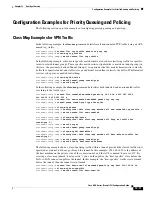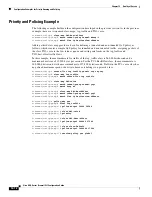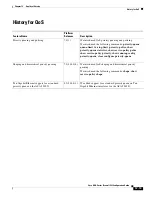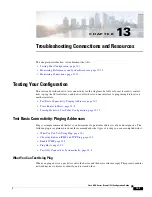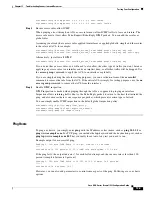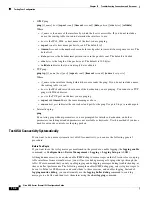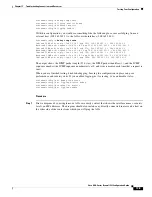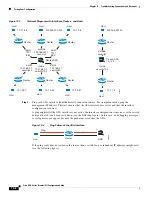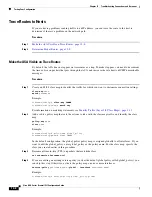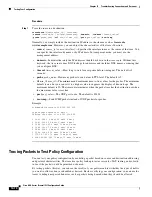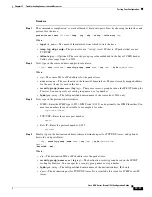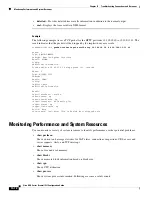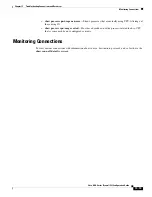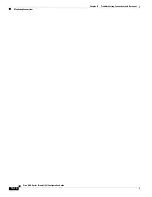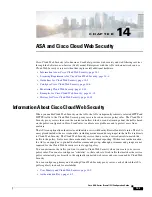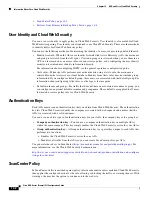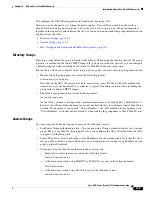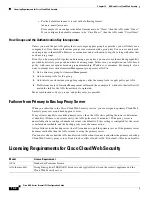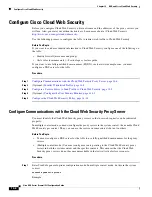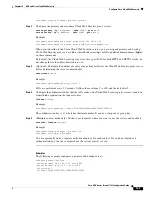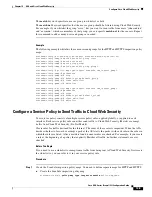
13-10
Cisco ASA Series Firewall CLI Configuration Guide
Chapter 13 Troubleshooting Connections and Resources
Testing Your Configuration
Procedure
Step 1
Trace the route to a destination.
traceroute
[
destination_ip
|
hostname
}
[
source
{
source_ip
|
source-interface
}] [
numeric
] [
timeout
timeout_value
]
[
probe
probe_num
] [
ttl
min_ttl
max_ttl
] [
port
port_value
] [
use-icmp
]
Normally, you simply include the destination IP address or hostname, such as
traceroute
www.example.com
. However, you can adjust the characteristics of the trace if desired:
•
source
{
source_ip
|
source-interface
}—Specifies the interface to use as the source of the trace. You
can specify the interface by name or by IP address. In transparent mode, you must use the
management address.
•
numeric
—Indicates that only the IP addresses should be shown in the trace route. Without this
keyword, the trace route does DNS lookups for addresses and includes DNS names, assuming that
you configure DNS.
•
timeout
timeout_value
—How long to wait for a response before timing out. The default is 3
seconds.
•
probe
probe_num
—How many probes to send at each TTL level. The default is 3.
•
ttl
min_ttl
max_ttl
—The minimum and maximum time-to-live values for the probes. The minimum
default is one, but you can set it to a higher value to suppress the display of known hops. The
maximum default is 30. The traceroute terminates when the packet reaches the destination or when
the maximum value is reached.
•
port
port_value
—The UDP port to use. The default is 33434.
•
use-icmp
—Send ICMP packets instead of UDP packets for probes.
Example
hostname# traceroute 209.165.200.225
Type escape sequence to abort.
Tracing the route to 209.165.200.225
1 10.83.194.1 0 msec 10 msec 0 msec
2 10.83.193.65 0 msec 0 msec 0 msec
3 10.88.193.101 0 msec 10 msec 0 msec
4 10.88.193.97 0 msec 0 msec 10 msec
5 10.88.239.9 0 msec 10 msec 0 msec
6 10.88.238.65 10 msec 10 msec 0 msec
7 172.16.7.221 70 msec 70 msec 80 msec
8 209.165.200.225 70 msec 70 msec 70 msec
Tracing Packets to Test Policy Configuration
You can test your policy configuration by modeling a packet based on source and destination addressing
and protocol characteristics. The trace does policy lookup to test access rules, NAT, routing, and so forth,
to see if the packet would be permitted or denied.
By testing packets this way, you can see the results of your policies and test whether the types of traffic
you want to allow or deny are handled as desired. Besides verifying your configuration, you can use the
tracer to debug unexpected behavior, such as packets being denied when they should be allowed.
Summary of Contents for ASA 5512-X
Page 5: ...P A R T 1 Service Policies and Access Control ...
Page 6: ......
Page 51: ...P A R T 2 Network Address Translation ...
Page 52: ......
Page 127: ...P A R T 3 Application Inspection ...
Page 128: ......
Page 255: ...P A R T 4 Connection Settings and Quality of Service ...
Page 256: ......
Page 303: ...P A R T 5 Advanced Network Protection ...
Page 304: ......
Page 339: ...P A R T 6 ASA Modules ...
Page 340: ......


